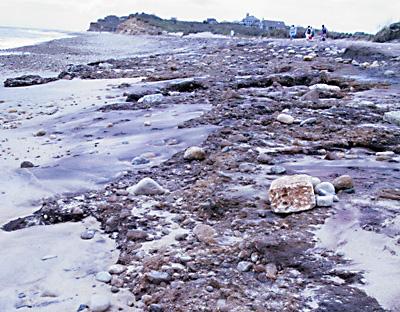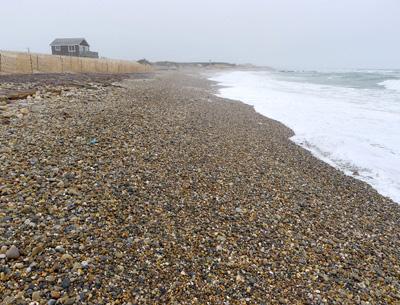All Aboard the L.I.R.R.'s Cannonball Express
All Aboard the L.I.R.R.'s Cannonball Express

A cold rain and a Memorial Day weekend weather forecast that looked more early March than late May was not enough to dampen the spirits of the 2,000 or so riders on the first Friday Long Island Rail Road Cannonball to ever leave from Penn Station, going nonstop to the Hamptons.
For decades, the Cannonball, pulled by a diesel-powered locomotive, would make the trip to Montauk beginning at the Hunter’s Point station in Long Island City. The bulk of the Cannonball’s riders would board an electrically powered train in Penn Station, changing trains at Jamaica. Now the Cannonball will be pulled by an electric engine out of Penn Station, and later switched to diesel power.
Mostly 20-somethings, with some older folk thrown in, filled the aisles and stairs of the double-decker cars on Friday, sitting on bags, suitcases, and, occasionally, each other.
Spirits flowed freely, laughter was infectious, and the police officers stationed on the train had little to do in the way of policing.
Deric Bradford was seated on the steps to the lower level of car three, next to his girlfriend, as he opened a bottle of wine. “It’s a nice rosé from Provence,” he said. He was headed to Bridgehampton. His Saturday night plans? Southampton Social Club.
“The Surf Lodge,” Jenn Nelson said of her Saturday night destination. She was headed to Montauk, as were many of the younger riders. While she loves the nightlife, she is also on a mission. “I’m launching a pop-up church.”
Ms. Nelson is a member of the Liberty Church in Manhattan. “We decided to launch services in Montauk Sunday mornings, for people who spend summer in the Hamptons.”
Absolut and ginger ale was the drink of choice for Tom Sadowski, who was headed to Westhampton Beach. “I’m going home after a long week in the city,” he said. He had friends coming over to ring in the season Saturday night.
“Excuse me,” Mr. Sadowski called out, trying to get a passing conductor’s attention. The outlet he had plugged his cellphone into had suddenly gone dead. The conductor said he would check and see if anything could be done.
“If not, just return the money for the ticket,” Mr. Sadowski said.
A few minutes later, the conducor returned with bad news: the outlet would be dead for the rest of the trip. No refund coming.
Alexandra Rosano and Conner Golden were bound for Montauk, seated in the fourth car’s upper deck. With luggage space at a premium, she had her weekender bag on her lap, along with her smartphone.
Matt Doherty and Kristin Phelps were headed to their share house in what Mr. Doherty called “Hampton Springs,” near Maidstone Park.
They’d spent the last two summers sharing a house in Westhampton. “We’re trying to get further out there towards Montauk,” Mr. Doherty said. Why? Because it is Montauk, he said. On Saturday, they’d be at “Sloppy Tuna, if it rains. Good for all ages,” he said.
“Cyril’s for B.B.C.,” said Ms. Phelps, “banana Bailey’s colada.”
Karoline Deutschmann was seated on the stairs by the bar in car five, holding her son, Anton, as he played a game on her smartphone. “This is my first time on the Cannonball,” she said. “If I was 23, 24, I would love it. Now?” she shrugged and smiled, “not so much.” But the rum and coke she was drinking certainly took the edge off the ride. Her husband, Andreas, was seated on the floor in the crowded vestibule on the other side of car five, a gray pug in a dog carrier next to him. “It could be worse,” he said.
Two young Frenchmen drinking Heineken were standing in the crowded aisle, next to their girlfriends, who had managed to get seats together.
“We came from France to see what East Hampton has to offer,” one of them said, before admitting that they were all living in New York and had been to the Hamptons before.
Their weekend plans? “Chill and drink and go out,” the second man said. “And be merry,” the first one added.
Chloe Bethel, headed for East Hampton, was one of the first on the train, and had found a seat next to her friends on car three. She spent some of the trip reading from her tablet.
Normally, she stays with family, but this weekend she would stay with friends, but still visit her grandmother. She planned on “drinking, regardless, ringing in the summer.”
Dawn Hunter spent the trip standing in the aisle, leaning against a seat, reading a paperback copy of Max Brooks’s “World War Z.” Her weekend plans? “Chilling, chilling, minding my business.”
A few of the riders were headed to work.
South Pointe is going to be the Southampton hotspot this year, according to Natasha Roberts, who will be working there and sharing a house in Sag Harbor with a few friends.
Some of the more mature riders looked back on the Cannonball years past with fond memories.
“I loved Hunter’s Point,” Lynn Friedman said.
For some riders, boarding the Cannonball at Hunter’s Point was the commuting equivalent of a New York Nirvana, like insider trading or buying something at wholesale.
“It was great. Not everybody knew about it,” Ms. Friedman said.
Avoiding the crush of bodies at Jamaica by boarding at Hunter’s Point was almost an art form to Holly Peterson, a novelist, and one that she is determined to continue, albeit in a different fashion.
Ms. Peterson had once again made an inside score on Friday, getting her six children and herself seated together on the Cannonball for their ride to Water Mill. Her daughter Eliza was sleeping curled up on the seat next to her, head on her lap.
“It’s like the fall of Saigon, with worse manners,” Ms. Peterson said of the mob scene boarding the Cannonball. “I felt very smug at Hunter’s Point. Now, it’s ruined.” When she arrived with her brood at Penn Station Friday, she was greeted with the same “Jamaica Station Bedlam” that she had avoided in the past.
But, as with many a New Yorker, the skill at making the deal was the thing.
“My strategy now is to flirt with the Long Island Rail Road guys,” she said. She succeeded, getting the inside scoop, the platform number in advance, and her family safely down onto the train before the hordes descended.
Rich Winter took one look at the mob at Penn Station before the 4:07 p.m. departure and skipped waiting on line, instead going straight to the train, happy to pay the $6 penalty to buy his ticket on board for the trip to Westhampton.
Tickets don’t just cost more for those who buy on board.
In past years, the connecting train left Penn Station at 3:58 p.m., which made it off-peak. The new time makes it a peak train. Multiply the $7.25 difference in price by the approximately 2,000 passengers on board, and you come up with an additional $14,500 per Friday trip for the L.I.R.R., and the Cannonball will run on the same schedule on Thursdays.
Friday’s train ended up 10 minutes late at its first stop in Westhampton.
“This is distinctly un-Cannonball-ish,” said Rich Donaldson, who sat opposite Ms. Friedman on the train. Strangers when they boarded, they seemed to be friends by the end of the trip.
The train began emptying at Westhampton and by the time it left East Hampton, its penultimate stop, the median age on board couldn’t have been more than 25.
The bar crew for the two reserved-seating-only parlor cars at the front of the train began cleaning up. Tips had been okay, said Jerry Voltaire, one of the crew.
Amazingly, the toilets in at least the first five cars of the train had survived, although, by their looks, just barely.
A conductor explained that the main reason the toilets on the double-deckers tend to fail is that the flush button shorts out when pressed rapidly three times in succession, but because there is a pause between push and flush, riders often press it again, leading to frequent failures.
The Cannonball pulled into Montauk a little before 7, greeted by a throng of taxi drivers calling out, “Taxi? Want a taxi?”
The season had, unofficially, officially begun.
The first cannonball rolls into Penn Station on May 24. Tom McMorrow, photos.
Like "the fall of Saigon" is how one passenger described the scene to board the train at Penn Station.
Christina Bruno and Natasha Robertson enjoy their beverages of choice on the ride out east.
Connor Golden and Alexandra Rosano survived the cramped luggage conditions.
The stairs were as good a spot as any for Deric Bradford to enjoy a fine Provincal rose.
The crew attempted to keep everyone happy on the ride out to Montauk.
Not everyone was happy, however.
By the last stop, all of the cares of the ride and the city were forgotten.








